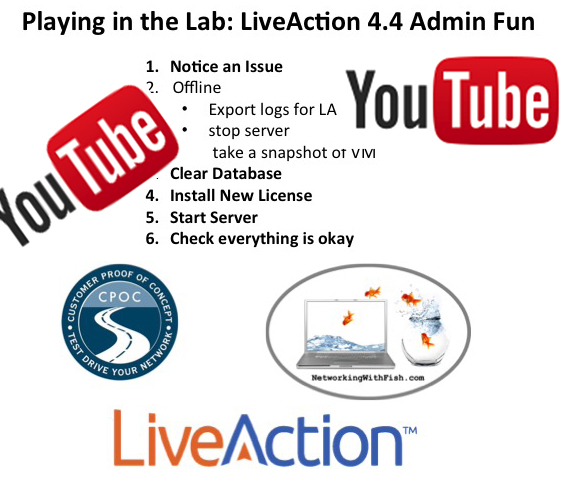Playing in the Lab: LiveAction Administrative Fun
I’m newer to LiveAction but what I have seen thus far I have definitely liked. But admittedly with GUIs I sometimes still feel like a “CLI girl living in a GUI world”.
During the past week I was noticing that when I was in my Live Action client view… looking at the “dashboard” I would suddenly find myself back at the main LiveAction client view. I asked a co-worker name Robert if he had ever seen that before. He had not. So I showed it to him. He noticed something I had not. There seemed to be a “trigger event” that was associated with the changing screens.
…. Hope you have fun with the video and playing in the lab with me. 
Click on the diagram below to go play. 
Approx time: 16 Minutes
Network Break 44
Network Break 44 analyzes cloud spending numbers from IDC, the impact of virtual appliances on hardware purchases, EMC and Symantec storage moves, and a new OpenStack appliance from Mirantis.
The post Network Break 44 appeared first on Packet Pushers.
Open Compute Software Interface Platform Control Demonstration
This four minute demonstration from Mellanox is really well done. It provides a simple and direct demonstration of the OCP Platform Control system. I note the simplicity of the linux commands to drive the configuration of the switch. Especially, if you use Ansible/Puppet etc, you will appreciate how easy it is to configure and monitor […]
The post Open Compute Software Interface Platform Control Demonstration appeared first on EtherealMind.
Network Break 44
Network Break 44 analyzes cloud spending numbers from IDC, the impact of virtual appliances on hardware purchases, EMC and Symantec storage moves, and a new OpenStack appliance from Mirantis.
Author information
The post Network Break 44 appeared first on Packet Pushers Podcast and was written by Drew Conry-Murray.
Let users choose enterprise cloud applications
This vendor-written tech primer has been edited by Network World to eliminate product promotion, but readers should note it will likely favor the submitter’s approach.
Asked whether he was considering a cloud application for his company, a CIO of a mid-size organization said the downside risk of ripping and replacing the company’s existing on-premises application outweighed the productivity gains the cloud application might bring. Part of that risk, he felt, was his job security.
That sentiment is common. IT professionals, after all, are responsible for keeping the organization’s applications running and ensuring the security of sensitive data. When they do decide to make a software change, IT leaders traditionally consider criteria such as:
To read this article in full or to leave a comment, please click here
Objectivity Never Rests

Being an independent part of the IT community isn’t an easy thing. There is a lot of writing involved and an even greater amount of research. For every word you commit to paper there is at least an hour of taking phone calls and interviewing leaders in the industry about topics. The rewards can be legion. So can the pitfalls. Objectivity is key, yet that is something where entire communities appear to be dividing.
Us Or Them
Communities are complex organisms with their own flow and feel. What works well in one community doesn’t work well in another. Familiarity with one concept doesn’t immediately translate to another. However, one thing that is universal across all communities is the polarization between extremes.
For instance, in the networking community this polarization is best characterized by the concept of “ABC – Anything But Cisco”. Companies make millions selling Cisco equipment every year. Writers and speakers can make a very healthy career from covering Cisco technologies. And yet there are a large number of companies and people that choose to use other options. They write about Juniper or install Brocade. They spend time researching Cumulus Linux or Big Switch Networks.
Knowing a little about Continue reading
Worth Reading: Open Container Project
The post Worth Reading: Open Container Project appeared first on 'net work.
Explaining the Mysteries of WiFi and Internet ;)
“Daddy, why is Internet not working even though I have good signal?”
“You really want to know?”
“Sure”
“OK, let me draw a diagram or two ;)”
… and now my 8-year old knows how DHCP and DNS works (root cause was a broken DNS proxy running on upstream $0.99 WAN router).


